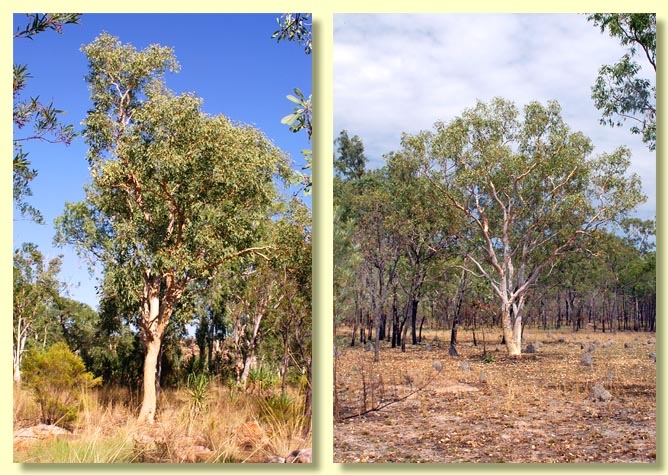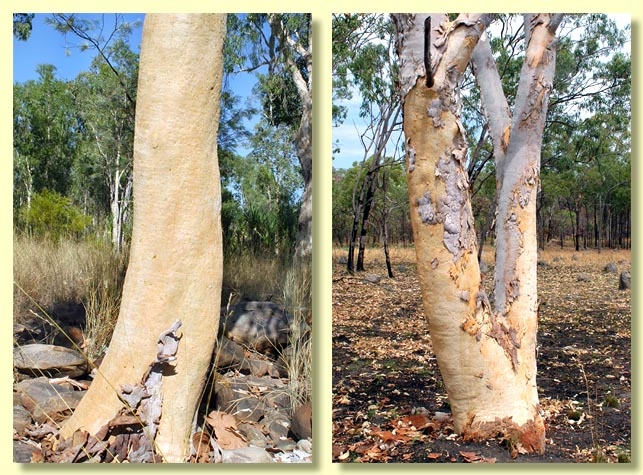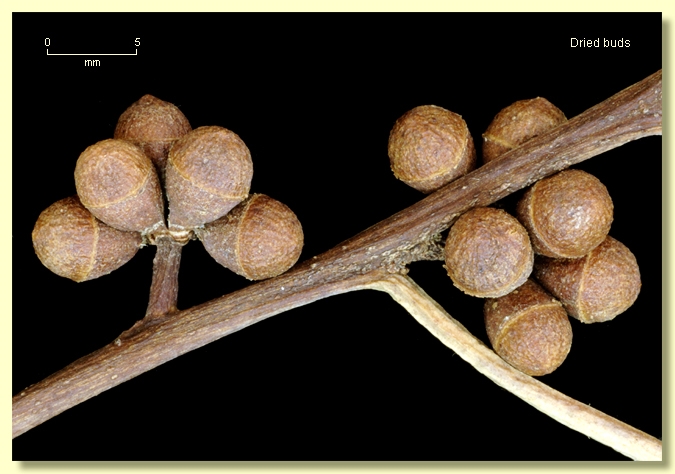Euclid - Online edition
Eucalyptus houseana
Eucalyptus | Symphyomyrtus | Exsertaria | Subexsertae | Applanatae
Eucalyptus houseana W.Fitzg. ex Maiden, J. & Proc. Roy. Soc. New South Wales 49: 318 (1916).
T: Isdell River, near Mt Barnett Homestead, Western Australia, May 1905, W.V.Fitzgerald 1014; holo: NSW; iso: PERTH.
Tree to c. 20 m tall. Forming a lignotuber.
Bark smooth throughout; newly exposed bark not powdery, pale pink to pale orange or buttery yellow, maturing to white or grey and powdery to touch.
Juvenile growth (coppice or field seedlings to 50 cm) : stems square in cross-section; juvenile leaves sessile to shortly petiolate, opposite, ovate to elliptical, 8–13 cm long, 5–9 cm wide, base broadly lobed to rounded.
Adult leaves alternate to sub-opposite, petiolate; blade lanceolate, sometimes falcate 9–19 cm long, (1.7)2–3.6(4.5) cm wide, base tapering to the petiole or rounded, margin entire, apex pointed, concolorous, dull green, side-veins acute or at a wider angle than 45° to the midrib, reticulation dense to very dense, intramarginal vein present, oil glands small, island and intersectional.
Inflorescence axillary unbranched, peduncles 0.2–0.5 cm long, buds 7 per umbel, sessile to shortly pedicellate (pedicels 0–0.1 cm long). Mature buds obovoid to ovoid to globular, 0.4–0.6 cm long, 0.3–0.5 cm wide, scar present, operculum rounded or rarely conical or shortly beaked (0.15–0.3 cm long), stamens usually regularly inflexed, sometimes irregularly inflexed, anthers oblong, versatile, dorsifixed, dehiscing by longitudinal slits, style long and straight, stigma blunt, locules 3 or 4, the placentae each with 6 or more vertical rows of ovules or the rows not clear. Flowers white.
Fruit sessile to shortly pedicellate (pedicels 0–0.1 cm long), obconical to hemispherical, 0.2–0.5 cm long, 0.3–0.5(0.6) cm wide, disc raised and annular or more or less level, valves 3 or 4, near the rim or slightly exserted.
Seeds brown to black-brown, 1–1.5 mm long, ± flattened ovoid, dorsal surface shallowly reticulate, edge of seed sharply toothed, hilum ventral.
Cultivated seedlings (measured at ca node 10): cotyledons oblong-reniform; stems square in cross-section; leaves always petiolate, opposite for 5 to 10 nodes then alternate, ovate, 4.5–10.5 cm long, 2.3–6 cm wide, base tapering to petiole, apex bluntly pointed, green, discolorous.
Flowering has been recorded in August.
A medium-sized tree, endemic to the plateau regions of the central western Kimberley region of Western Australia, from Mt Brookes in the north, then south through parts of the Prince Regent River Reserve to west of Mt Elizabeth Station and the King Leopold Range. Prefers growing on seasonally flooded, low-lying areas or along watercourses, and on damp flats on sandy soil. Characterised by the smooth white powdery bark in season, the distinctly petiolate, concolorous, green, lanceolate adult leaves and the small buds and fruit.
Eucalyptus houseana belongs to a small group of species closely related to the red gums. This group is distinguished by having smooth powdery bark, adult leaves with dense to very dense venation and intersectional or absent oil glands, buds with inflexed stamens, fruit with an annular disc and more or less flattened, toothed seeds with a ventral hilum. Other members of this group are E. bigalerita, E. platyphylla, E. tintinnans, E. apodophylla and E. alba.
Within this group, E. houseana is probably closest to E. apodophylla and can be distinguished by having alternate to sub-opposite, distinctly petiolate, dull green, concolorous, adult leaves and small fruit, no wider than 0.6 cm (E. apodophylla normally with opposite to sub-opposite, sessile to shortly petiolate, dull blue-grey to glaucous, discolorous, leaves in the mature crown and fruit always wider than 0.7 cm). E. houseana is also close to E. alba var. australasica and E. platyphylla and is weakly distinguished from both by having slightly smaller, sessile to shortly pedicellate buds and fruit (fruit 0.6 cm or narrower) with the valves near the rim of the fruit or slightly exserted (fruit normally 0.5 cm or wider in E. alba and E. platyphylla and valves prominently exserted). It is easily distinguished from E. bigalerita and E. tintinnans by its adult leaf shape. E. houseana has lanceolate adult leaves while both E. bigalerita and E. tintinnans have deltoid to orbicular adult leaves.
Within its area of occurrence, E. houseana may be confused with other related white gums, i.e. E. brevifolia, E. confluens, E. cupularis, E. herbertiana, E. mooreana, E. ordiana, E. pantoleuca and E. rupestris.
E. brevifolia and E. confluens can be distinguished by having larger fruit with a broad flat disc. (The fruit in E. brevifolia and E. confluens is 0.6 cm or wider, while the fruit in E. houseana is 0.6 cm or narrower and the disc is annular and not broad.) E. confluens can be further separated by having glossy adult leaves (always dull in E. houseana). E. cupularis and E. herbertiana are distinguished by having prominently exserted valves of the fruit, while the valves of E. houseana are near the rim of the fruit or only slightly exserted. E. cupularis can be further separated by having much larger fruit, always wider than 0.7 cm. E. mooreana has opposite, sessile, elliptical to ovate adult leaves, while the adult leaves of E. houseana are normally alternate, lanceolate and distinctly petiolate. E. ordiana is distinguished by having ovate, blue-grey to glaucous adult leaves, while E. houseana has dull green, lanceolate adult leaves. E. pantoleuca is easily distinguished by having large, orbicular to deltoid leaves in the mature crown and three-budded umbels (seven-budded in E. houseana). E. rupestris has shorter, more or less ovate adult leaves, normally shorter than 8 cm, while E. houseana has lanceolate adult leaves normally longer than 9 cm.
Eucalyptus houseana: named after Dr. Frederick Maurice House (1865–1936). After qualifying in medicine at St Thomas’s London, Frederick House migrated to Western Australia in 1891. In 1892 he became a government medical officer in various country areas until his retirement in 1918. In 1901 he was naturalist with the government exploring party, under the leadership of F.S. Brockman, to the far north of Western Australia between latitudes 14° and 17°. Mt House, from this area, was also named in his honour by Frank Hann, another explorer. The name Eucalyptus houseana was first mentioned by Fitgerald in the Western Mail, Perth 2nd June 1906.













